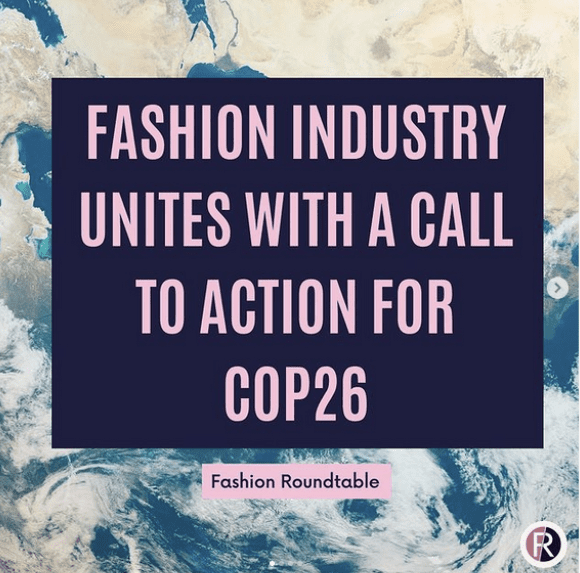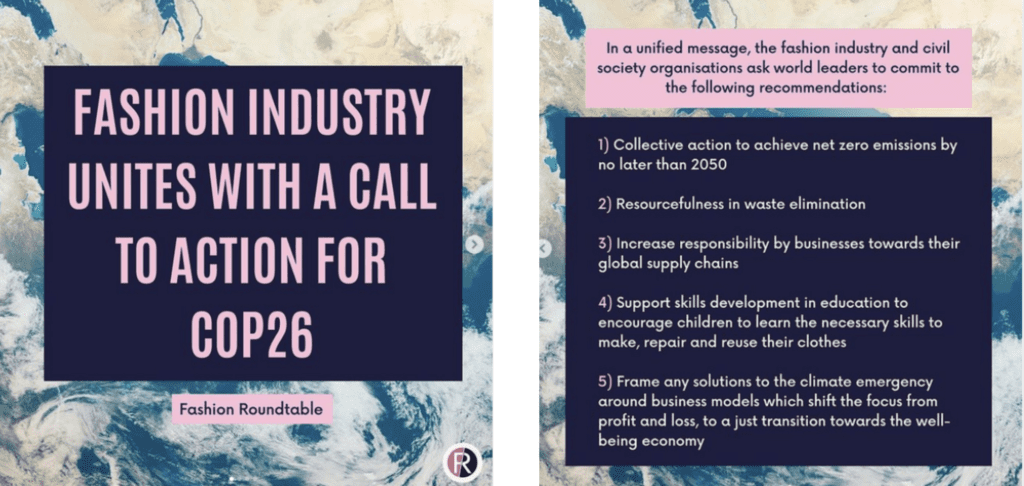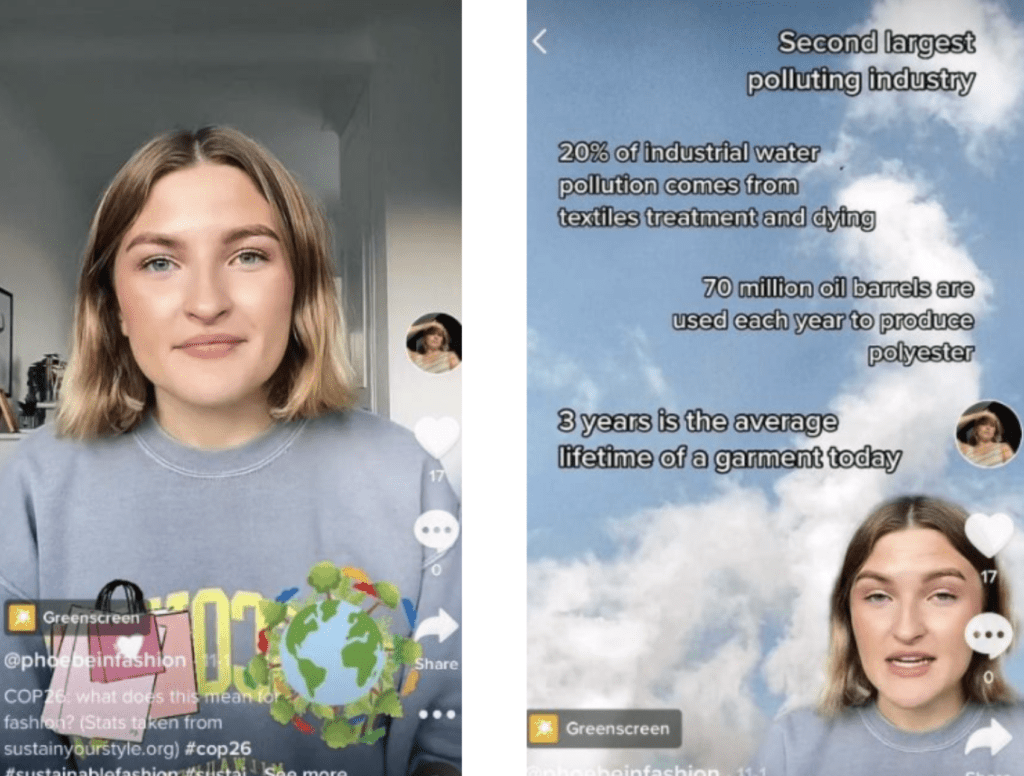
World leaders came together over the last few weeks to discuss solutions for the climate crisis and set goals to help stop rising emissions levels and move towards a more sustainable future. Though one crucial topic surprisingly remained off the official agenda at COP26 – the fashion industry – which alone accounts for around 2% of all the emissions worldwide and yet was not once mentioned in any of the resulting goals of the most important international conference on climate.
All over social media, and looking closer at the protests and side-events around this conference, it did not take much time for me to notice the disappointment of sustainability changemakers and activists in the fashion industry. They had many ideas and solutions to present but very few opportunities to discuss them with decision-makers on the COP26 main stage.
I spoke to some of them attending the conference to bring their valuable insights and feedback to you.
Fashion at COP26 – the hidden heroes
While state representatives did not have fashion-related panels on their schedule, the sustainable fashion community did not miss the opportunity to attend COP26 and bring innovative solutions.
Before the conference, they released an open letter to governments with over 450 signatories across the industry, asking them to recognize the vital role of fashion in finding solutions for the climate crisis. Sustainability supporters and even magazines like Grazia and Forbes spread the powerful call-to-action with their communities, recognizing the urgency of the matter.
We asked Tamara Cincik, CEO and founder of the Fashion Roundtable – one of the leaders of this initiative – how the fashion industry issues and sustainable solutions were addressed at COP from her perspective:
“The climate crisis needs all players in the room, and fashion, alongside STEAM and creative industry partners, have been sidelined (at COP26). Tech must be creative, as do all sustainable solutions if we are to end this emergency with workable strategies. Fashion is part of the problem and needs to be a part of the solution.”

The famous climate summit took place in Scotland, and of course, local representatives of the sustainable community did not miss the event. Mairi Lowe, the founder of Sustainable Fashion Scotland, attended COP26 on behalf of Fashion Revolution Scotland and shared her insights. We talked with Mairi about what she believed was missing from the conversations and action plans at COP26. Her answer: Fashion.
“Unsurprisingly, the fashion industry and its extractive and exploitative issues were hugely absent from official COP conversations. I say unsurprisingly as fashion is often undervalued and not taken seriously by governments and policymakers. Fashion is perceived as frivolous, when in fact it is fundamental in climate justice discussions due to the pervasive, negative environmental and social impacts caused by our overproduction and overconsumption of clothing.”
The Generation of Waste team Mairi was a part of, received an exhibit space to communicate why fashion should be included in climate discussions through eye-opening facts and figures, but this was simply not enough. Even though the fashion industry could have been a topic of discussion at COP, it was left on the sidelines.
“For me, the best fashion events at COP26 were outside of the official exclusive space, such as the ‘Changing Market’s ‘How Fossil Fuels are the Backbone of Fast Fashion’ event, where I felt like I was part of the conversation and could connect with other passionate people working in sustainable fashion rather than just being an observer.”
Ruth MacGilp, ethical fashion writer and the communication and content manager of Fashion Revolution, shared similar insights from her COP experience. In her opinion, the conference too often highlighted greenwashing practices, leaving affected stakeholders like the people #whomadeourclothes behind.
“Fashion was largely left off the agenda at COP, despite being a universal touchpoint not only culturally, but also for every major sector from fossil fuel extraction to agriculture. When it was addressed, corporate greenwashing was given a platform over the voices of the most affected people in the supply chain, who not only suffer at the hands of fashion’s exploitative working practices but are already experiencing the impacts of the climate crisis. We will not build a sustainable fashion future without systemic change that includes justice for supply chain workers and a shift away from exponential growth, not just tinkering around the edges of circularity.“
Fashion Highlights at the COP
Speaking with these engaged NGOs, it became clear that the COP efforts on fashion were far from enough. We looked for other voices who could shine a light on the topic to bring in further perspectives. We asked multiple stakeholders for examples of how the fashion issue was addressed at the climate conference – very few of them showcased actions from governments or were part of the official programme.
We reached an organizer of Changing Markets – a side event on fashion that took place during COP26.
Amy Nguyen is a sustainability contributor at Forbes and the founder of @sustainablenandsocial, a platform dedicated to sharing the value of sustainable development with the world. She shared with us that one topic around fashion did fall under the spotlight at COP in the second week – material sourcing, though again – way too short.
“Whilst it was great to see the issues of the industry discussed at COP, the conversations have not gone far enough. It would be welcome to see brands set clear targets on how they are going to minimize the number of items they make each year as opposed to increasing production and justifying it by using ‘sustainable’ or ‘innovative’ materials. Most pressing for me is the failure to link the popularity of synthetic fabrics with climate targets”.
In her work at the Changing Markets Foundation through the Fossil Fashion campaign, Amy and the team have uncovered how often synthetic materials can be found in collections across the fast fashion, mass-market and luxury domains. Their research has found that these materials further encourage throw-away fashion, increase waste to landfill, and encourage a dependency on fossil fuels. Amy was happy to witness conversations about this at COP26 but mentioned that they were still filled with greenwashing statements, inaction, and under-representation.
“Climate ambitions and net-zero targets often fail to discuss material sourcing, and this is a critical factor that is missing. For instance, many of the world’s leading global fashion brands have signed up to the Science-Based Targets initiative, yet few have aligned these targets to their material sourcing policies. With many representatives from the Global South and those countries on which fashion supply chains rely, unable to attend the conference, key voices in the industry were not included in the debates. We need democratic discussions that are not dominated by western corporations. Conferences like COP26 are an important platform to showcase the great work that is being done in the industry, but we need to be aware of the greenwashing that is still allowed to take place at these events which can pull the wool over the eyes of policymakers and citizens.’ ”
Hattie Webb, is a volunteer sustainability researcher with Give your Best UK, a social enterprise empowering women refugees through an online catalogue where they can “shop” their best donated items. She shared a few interesting highlights that brought fashion closer to world leaders.
She mentioned the GREAT fashion for climate action showcase by the British Fashion Council, presenting sustainable practices from UK brands and the ‘Future of Fashion: An innovation conversation with Stella McCartney’ exhibit exploring a nature-positive approach to fashion – some of the few fashion-related activations on the COP26 agenda.
These actions were empowering and eye-opening, but Hattie still thinks more could have been done at the conference to address issues and solutions in the industry, especially from the UN working group on fashion.
“As Stella Mccartney has said at the conference, the future of fashion looks bleak, and we need more action from political leaders. I would have liked to see more from The Fashion Industry Charter for Climate Change, the UN’s fashion industry working group created at COP24 consisting of 130 companies and 41 supporting organizations. The Charter’s long-term aim is for the industry to achieve Net Zero by 2050, and it seems their 2018 Charter has been renewed with more specifics – but again this seems like another empty pledge without proof and people in mind. Where are the clear, targeted actions plans for making the fashion industry more sustainable?“
Youth Views on the Future of Fashion
We have heard from people from the fashion industry so far, many focusing on sustainability in their work, but there is one more perspective I would like to include in this conversation: the voice of youth. They were present in COP26 discussions, be it online via social media like TikTok or Instagram, or live in Glasgow as part of the Fridays For Future movement, alongside Greta and many other young, powerful climate activists from all around the world.
Let’s hear what they have to say.
Out of many young people sharing their views on climate action on TikTok, I reached out to @phoebeinfashion – an aspiring sustainable fashion content creator that recently posted a TikTok on COP26: what does this mean for fashion? – expressing her hopes to see the entire fashion industry taken under the microscope at the conference by world leaders. These are her conclusions a few weeks after her call-for-action on Tiktok.
“I personally feel that fashion hasn’t yet had the attention it deserves to progress in a sustainable and conscious way. Through a fashion lens, a lot of demand comes from the West in terms of ramping up clothing manufacturing in countries such as Bangladesh, Taiwan and China. Yet there is the tone that Western countries expect them to “clean up” and go green for pennies per item, despite us being the ones fueling the demand.”

Beyond expressing the urgent need for policy change to back up positive efforts by brands, Phoebe also stressed the need for a push for educational efforts among the public.
“There needs to be education on a consumer level. The fashion industry has grown to this uncontrollable giant due to unprecedented consumer demand that has built over the past 30 years. If consumers were educated properly on their clothing (who made it, where it came from, its environmental impact), it may help people make better decisions. It needs to be everyone, not just people “into fashion” or “into sustainability. I strongly believe that fashion can exist in a positive way, but we need tough legislation from the people in charge and a change of mindset from the everyday consumer.”
Initiatives like Phoebe described above already exist on a grassroots level. This is exactly what FTA is doing with the @myclothesmyworld youth education program where they teach young people aged 8-17 about the broader climate change issues, through the lens of fashion which is far more fun and relatable for them.
#FridaysforFuture quickly recognized the missing link to fashion at COP26 as well. We spoke with Isabel Bracamontes, a young entrepreneur and the founder of Fridays for Future Yucatan, about her COP experience and feedback on the discussions around fashion.
Initiatives like Phoebe described above already exist on a grassroots level. This is exactly what FTA is doing with the @myclothesmyworld youth education program where they teach young people aged 8-17 about the broader climate change issues, through the lens of fashion which is far more fun and relatable for them.
#FridaysforFuture quickly recognized the missing link to fashion at COP26 as well. We spoke with Isabel Bracamontes, a young entrepreneur and the founder of Fridays for Future Yucatan, about her COP experience and feedback on the discussions around fashion.
“The only thing related to fashion that I saw at COP were statistics on the wall, though no solutions or proposals presented. I found there was a lack of ambition in really combating the environmental problem of fashion. I did not see serious and professional interest and have come to question the missing action in setting limits, sanctions, proposals, and initiatives around the world for this huge industry.”
COP 26 and now what?
When you open the outcome pact of COP26 and use the search tool to look for fashion, clothes or textiles, as expected, the result is “not found.” Does this also mean that world leaders did not find the fashion industry with its overproduction, textile waste, pollution, and human rights violations to be a problem big and important enough to discuss and create common steps to change it?
Sadly, as we have heard from the activists and changemakers representing sustainable fashion solutions and advocacy at the conference, fashion’s impact on climate remains underestimated.
I guess it means yet another year of advocating for fashion to be addressed at COP27, should it not be too late by then – because one thing we all know is that the climate crisis does not wait for the next conference to happen, and neither should we.
As Greta perfectly put it:
“The real work continues outside these halls – and we will never give up, ever.”
My message to all the activists and doers I spoke with and others fighting for change on a grassroots level is to stay strong and keep doing what you do.
To the world and industries that looked away this year on fashion, get inspired by these innovative and critical solutions the sustainable fashion community tried to bring before you this year. Do not wait for 2050 to start shaping the future of fashion.
